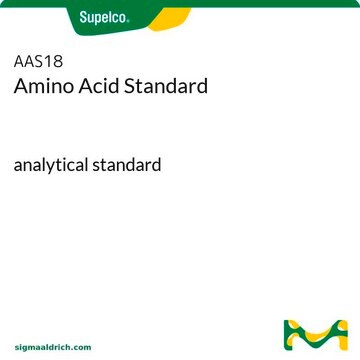Products may be shipped at a different temperature than the recommended long-term storage temperature. If the product quality is sensitive to short-term exposure to conditions other than the recommended long-term storage, it will be shipped on wet or dry-ice. If the product quality is NOT affected by short-term exposure to conditions other than the recommended long-term storage, it will be shipped at ambient temperature. As shipping routes are configured for minimum transit times, shipping at ambient temperature helps control shipping costs for our customers. For more information, please refer to the Storage and Transport Conditions document: https://www.sigmaaldrich.com/deepweb/assets/sigmaaldrich/marketing/global/documents/316/622/storage-transport-conditions-mk.pdf
A3007
N-乙酰胞壁酸
≥98% (TLC)
别名:
( R )-2-(乙酰氨基)-3- O -(1-羧乙基)-2-脱氧- D -葡萄糖, 2-乙酰胺基-2-脱氧-3- O -( D -1-羧乙基)- D -吡喃葡萄糖, MurNAc, NAMA
选择尺寸
About This Item
推荐产品
生物来源
synthetic
方案
≥98% (TLC)
表单
powder
技术
thin layer chromatography (TLC): suitable
杂质
≤1 mol/mol methanol
颜色
white
mp
125 °C ((257 °F ))
溶解性
water: 50 mg/mL, clear, colorless
储存温度
2-8°C
SMILES字符串
CC(O[C@H]1[C@H](O)[C@@H](CO)OC(O)[C@@H]1NC(C)=O)C(O)=O
InChI
1S/C11H19NO8/c1-5(11(18)19)20-10(9(17)8(16)4-14)7(3-13)12-6(2)15/h3,5,7-10,14,16-17H,4H2,1-2H3,(H,12,15)(H,18,19)/t5-,7+,8-,9-,10-/m1/s1
InChI key
SOARVSUSWULNDI-TVVSKHENSA-N
正在寻找类似产品? 访问 产品对比指南
警示用语:
Warning
危险声明
危险分类
Acute Tox. 4 Oral - STOT SE 2
靶器官
Eyes,Central nervous system
储存分类代码
6.1C - Combustible acute toxic Cat.3 / toxic compounds or compounds which causing chronic effects
WGK
WGK 3
闪点(°F)
Not applicable
闪点(°C)
Not applicable
个人防护装备
Eyeshields, Faceshields, Gloves, type P2 (EN 143) respirator cartridges
其他客户在看
-
How is shipping temperature determined? And how is it related to the product storage temperature?
1 answer-
Helpful?
-
-
How can I determine the shelf life / expiration / retest date of this product?
1 answer-
If this product has an expiration or retest date, it will be shown on the Certificate of Analysis (COA, CofA). If there is no retest or expiration date listed on the product's COA, we do not have suitable stability data to determine a shelf life. For these products, the only date on the COA will be the release date; a retest, expiration, or use-by-date will not be displayed.
For all products, we recommend handling per defined conditions as printed in our product literature and website product descriptions. We recommend that products should be routinely inspected by customers to ensure they perform as expected.
For products without retest or expiration dates, our standard warranty of 1 year from the date of shipment is applicable.
For more information, please refer to the Product Dating Information document: https://www.sigmaaldrich.com/deepweb/assets/sigmaaldrich/marketing/global/documents/449/386/product-dating-information-mk.pdfHelpful?
-
Active Filters
我们的科学家团队拥有各种研究领域经验,包括生命科学、材料科学、化学合成、色谱、分析及许多其他领域.
联系技术服务部门











